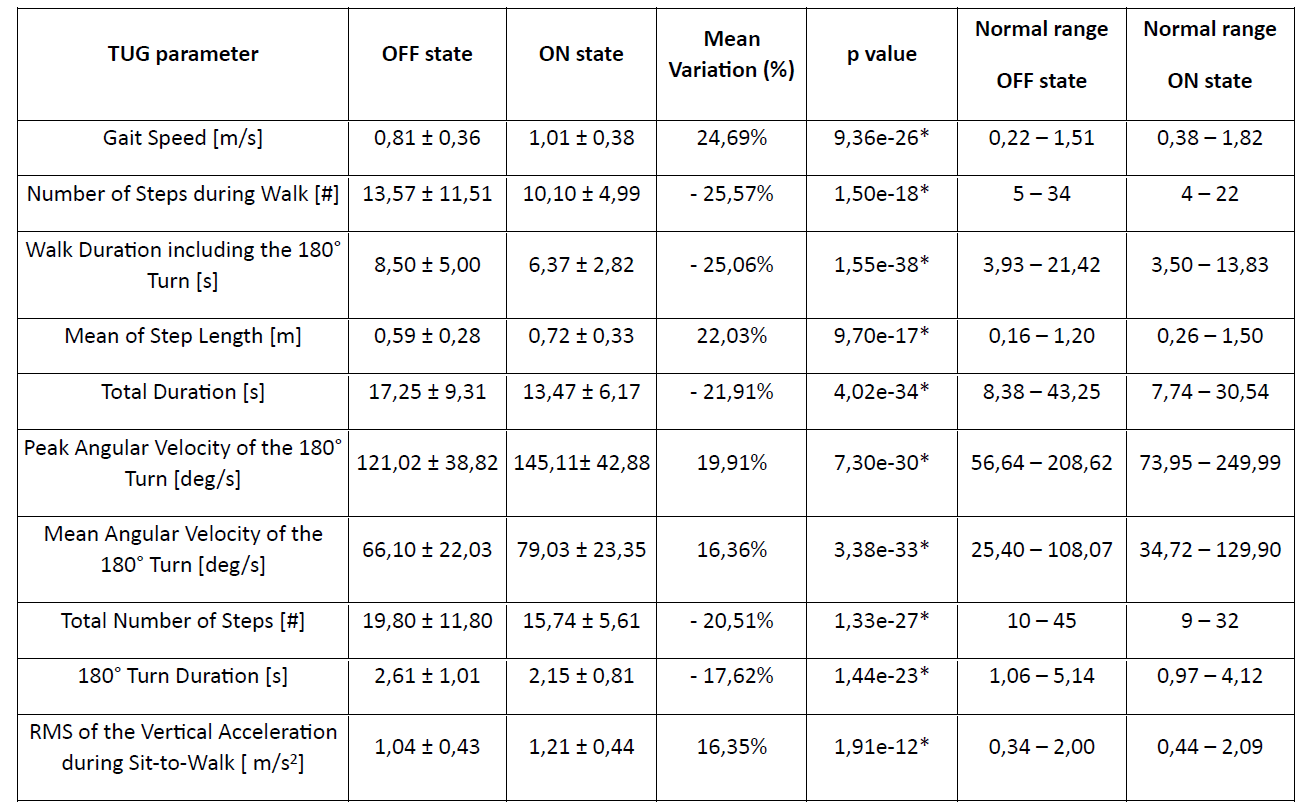Category: Technology
Objective: This study aims to define normative values for the Instrumented Timed Up and Go test using wearable inertial sensors in people affected by Parkinson’s disease and parkinsonism.
Background: Parkinson’s disease and atypical parkinsonism (such as Progressive Supranuclear Palsy, Multiple System Atrophy) are neurodegenerative disorders characterized by motor and non-motor symptoms [1]. In addition to clinical rating scales (e.g., MDS-UPDRS), wearable sensors can also be used to assess and monitor disease progression. For example, the Instrumented Timed Up and Go test (iTUG) provides a quantitative and reliable measure of functional mobility [2]. This study aims to analyze motor parameters assessed using wearable inertial sensors to define normative values for iTUG in Parkinsonian populations.
Method: 310 persons with Parkinson’s disease and parkinsonism on chronic levodopa (LD) were recruited to perform iTUG using a single Inertial Measurement Unit (IMU) worn on the lower back. Blood samples were also taken to measure plasma drug concentrations. The iTUG test was performed immediately before the LD intake (OFF state) and 75 minutes after the drug administration (ON state) to assess the motor efficacy of LD-based treatment. 21 state-of-the-art parameters were extracted from the inertial signals to assess locomotor patterns (e.g., gait speed, step length) and time constraints (e.g., total duration, 180° turn duration).
Results: Table 1 reports the normative values for the 10 motor parameters that showed the largest change between the OFF and ON states. All of them show a statistically significant change (p<0.001). Gait speed is the parameter that improved the most after the LD administration. All parameters improved in the ON state, highlighting the efficacy of the pharmacological treatment.
Conclusion: Normative values for 21 sensor-derived motor parameters of iTUG in a Parkinsonian population have been defined for the OFF and ON conditions. Parameters quantitively assess motor function being sensitive to the pharmacological state. Further analysis comparing the normative values in the different subgroups of patients will provide more detailed results on the observed differences.
References: [1] Postuma RB, Berg D, Stern M, et al. MDS clinical diagnostic criteria for Parkinson’s disease. Mov Disord. 2015;30(12):1591-1601. doi:10.1002/mds.26424
[2] Höglinger GU, Respondek G, Stamelou M, et al. Clinical diagnosis of progressive supranuclear palsy: The movement disorder society criteria. Mov Disord. 2017;32(6):853-864. doi:10.1002/mds.26987
[3] Gilman S, Wenning GK, Low PA, et al. Second consensus statement on the diagnosis of multiple system atrophy. Neurology. 2008;71(9):670-676. doi:10.1212/01.wnl.0000324625.00404.15
[4] Salarian A, Horak FB, Zampieri C, Carlson-Kuhta P, Nutt JG, Aminian K. iTUG, a sensitive and reliable measure of mobility. IEEE Trans Neural Syst Rehabil Eng. 2010;18(3):303-310. doi:10.1109/TNSRE.2010.2047606.
To cite this abstract in AMA style:
L. Palmerini, I. D'Ascanio, A. Giannoni, G. Calandra-Buonaura, G. Giannini, L. Chiari, P. Cortelli, G. Lopane. Normative values for the Instrumented Timed Up and Go test in Parkinsonian populations [abstract]. Mov Disord. 2023; 38 (suppl 1). https://www.mdsabstracts.org/abstract/normative-values-for-the-instrumented-timed-up-and-go-test-in-parkinsonian-populations/. Accessed January 4, 2026.« Back to 2023 International Congress
MDS Abstracts - https://www.mdsabstracts.org/abstract/normative-values-for-the-instrumented-timed-up-and-go-test-in-parkinsonian-populations/

